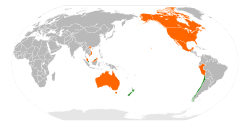Trans-Pacific Strategic Economic Partnership Agreement
|
parties to the trade agreement | |
| Type | Trade agreement |
|---|---|
| Drafted | 3 June 2005[1][2] |
| Signed | 18 July 2005[3][4][5] |
| Location | Wellington, New Zealand |
| Effective | 28 May 2006[6] |
| Condition | 2 ratifications |
| Parties | |
| Depositary | Government of New Zealand[4] |
| Languages | English and Spanish, in event of conflict English prevails[4] |
The Trans-Pacific Strategic Economic Partnership Agreement (TPSEP) is a trade agreement between four Pacific Rim countries concerning a variety of matters of economic policy. The agreement was signed by Brunei, Chile, Singapore and New Zealand in 2005 and entered into force in 2006. It is a comprehensive trade agreement, affecting trade in goods, rules of origin, trade remedies, sanitary and phytosanitary measures, technical barriers to trade, trade in services, intellectual property, government procurement and competition policy. Among other things, it called for reduction by 90 percent of all tariffs between member countries by 1 January 2006, and reduction of all trade tariffs to zero by the year 2015.[7]
Earlier agreements
By 2001, New Zealand and Singapore had concluded the Agreement between New Zealand and Singapore on a Closer Economic Partnership (NZSCEP). The Trans-Pacific Strategic Economic Partnership Agreement built on the NZSCEP.[8]:5
Negotiations
During the 2002 Asia-Pacific Economic Cooperation (APEC) Leaders' Meeting in Los Cabos, Mexico, Prime Ministers Helen Clark of New Zealand, Goh Chok Tong of Singapore and Chilean President Ricardo Lagos began negotiations on the Pacific Three Closer Economic Partnership (P3-CEP).[8]:5 According to the New Zealand Department of Foreign Affairs and Trade,[8]:5
"The shared desire was to create a comprehensive, forward-looking trade agreement that set high-quality benchmarks on trade rules, and would help to promote trade liberalisation and facilitate trade within the APEC region."— Ministry of Foreign Affairs and Trade, New Zealand 2005
Brunei first took part as a full negotiating party in April 2005 before the fifth, and final round of talks.[9] Subsequently, the agreement was renamed to TPSEP (Trans-Pacific Strategic Economic Partnership agreement or Pacific-4). Negotiations on the Trans-Pacific Strategic Economic Partnership Agreement (TPSEP or P4) were concluded by Brunei, Chile, New Zealand and Singapore on 3 June 2005,[2] and entered into force on 28 May 2006 for New Zealand and Singapore, 12 July 2006 for Brunei, and 8 November 2006 for Chile.[10]
Parties
| Party | Signature[4] | Entry into force[4] |
|---|---|---|
| | 2 August 2005 | 29 July 2009 |
| | 18 July 2005 | 8 November 2006 |
| | 18 July 2005 | 1 May 2006 |
| | 18 July 2005 | 1 May 2006 |
Although the TPSEP agreement contains an accession clause and affirms the members' "commitment to encourage the accession to this Agreement by other economies", no such accession have taken place.[9][11] All four countries were involved however in the negotiations for the Trans-Pacific Partnership Agreement, about which agreement was reached in 2015 involving 8 additional parties.
The TPSEP (and the TPP it grew into) are not APEC initiatives. However, the TPP is considered to be a pathfinder for the proposed Free Trade Area of the Asia Pacific (FTAAP), an APEC initiative.
See also
References
- ↑ "Brunei Darussalam, Chile, New Zealand and Singapore conclude negotiations on a Trans-Pacific Strategic Economic Partnership Agreement" (Press release). Joint Press Statement from Brunei Darussalam, Chile, New Zealand and Singapore Ministers. 3 June 2005. Archived from the original on 7 September 2006. Retrieved 15 December 2012.
Brunei Darussalam Ambassador-at-Large Princess Masna, Chilean Minister of Foreign Affairs Mr Ignacio Walker, New Zealand Minister for Trade Negotiations Hon Jim Sutton, and Singapore Minister for Trade and Industry Mr Lim Hng Kiang today announced the successful conclusion of negotiations for a Trans-Pacific Strategic Economic Partnership Agreement (Trans-Pacific SEP).... The Ministers will recommend the results of the negotiations to their respective governments for signature.
- 1 2 "Brunei, Chile, New Zealand and Singapore reach trans-Pacific FTA". The Manila Bulletin. Reuters. 3 June 2005. Retrieved 15 December 2012.
- ↑ "Second free trade agreement to be signed by NZ this year" (Press release). New Zealand Government. 18 July 2005. Retrieved 7 October 2015.
The first multi-party free trade agreement spanning the Pacific and Asia was signed today in a ceremony at Parliament, announced Prime Minister Helen Clark.
- 1 2 3 4 5 "Treaties for which NZ is Depositary: Trans-Pacific Strategic Economic Partnership (TPSEP or P4)". Retrieved 15 December 2012.
- ↑ "FTA signed: NZ, Chile, Singapore and Brunei to end tariffs". The National Business Review. 19 July 2005. Retrieved 15 December 2012.
- ↑ "Trans-Pacific Strategic Economic Partnership Agreement: Understanding the P4 – The original P4 agreement". Retrieved 15 December 2012.
The agreement provisionally entered into force (between New Zealand and Singapore only) on 1 May and officially entered into force on 28 May. The Agreement entered into force for Brunei on 12 July 2006, and for Chile on 8 November 2006.
- ↑ "Trans-Pacific Strategic Economic Partnership Agreement" (PDF). NZ Ministry of Foreign Affairs & Trade. 2005. Retrieved 28 January 2012.
- 1 2 3 "Trans-Pacific Strategic Economic Partnership Agreement national interest analysis" (PDF), Ministry of Foreign Affairs and Trade (New Zealand), July 2005, ISBN 0-477-03793-3, retrieved 5 August 2015
- 1 2 "History of the Trans-Pacific SEP Agreement P4". mfat.govt.nz.
- ↑ "Trans-Pacific Strategic Economic Partnership Agreement: Understanding the P4 – The original P4 agreement". Retrieved 15 December 2012.
- ↑ "TRANS-PACIFIC STRATEGIC ECONOMIC PARTNERSHIP AGREEMENT" (PDF). mfat.govt.nz. Retrieved 5 October 2015.
